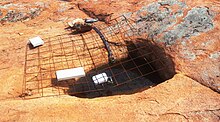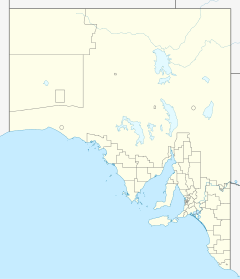Hiltaba Nature Reserve
32°10′S 135°04′E / 32.16°S 135.07°E
Hiltaba Nature Reserve is located in the north of the Eyre Peninsula on the western edge of the Gawler Ranges, South Australia. It is situated on a former pastoral lease known as Hiltaba, or Hiltaba Station, that had operated as a sheep station. It is owned by the Nature Foundation, which purchased the property in 2012.
History

The
Around 1844,

Yardea was the only permanent station west of the ranges, although over time the boundaries, owners, and managers changed, and occasionally the station was only utilised for winter pasture. The original (now roofless) residence and the dam were constructed by the Fitzgerald brothers, who resided there from approximately 1892 until 1912. The lease was purchased by Carl Hermann Nitschke in 1918 and has been in his family ever since. His son, test cricketer
Cattle were introduced from time to time, but the numbers of both cattle and sheep fluctuated. In 1918, there were about 2,000 sheep and a few hundred cattle; by 1939, there were 11,500 sheep. Cattle were removed from the property in the 1960s. Rabbits, dingoes, kangaroos, feral goats, irregular rainfall, and saline water all contributed to making it hard to make a good living out of farming on the property.[3]
The MacLachlan family purchased Hiltaba in 1986, in 1995 transferring it to Janet Angas (née MacLachlan) and her husband Alastair.[3]
After the
One of the main purposes of creating the nature reserve is to help to create an almost completely unbroken east-west corridor
In 2018 two budget bush campgrounds were opened on the property: one at Pretty Point, with only a toilet, no showers, while the one at the Old Shearers Quarters has showers and toilets.[7]
Description

Hiltaba Nature Reserve adjoins the
The 78,000 ha (190,000-acre) property includes unique and significant geological formations composed of

The foundation has created driving and walking tracks, as well as fireplaces and accessible fuel for campers.[6] The property remains a pastoral lease, and adjoining landholders help to manage issues like stray stock, dingoes, and feral goats.[5]
Apart from the substantial bungalow built by Slinger Nitschke, there are also several other structures on the property:[3]
- The woolshed, which has been substantially restored by volunteers
- Shearers' Quarters, now used as accommodation for guests
- Several dams
- The original home built by the Fitzgerald brothers
- The "Governes's cottage
- The grave of an 11-month-old infant who lived in Kondoolka Station to the north-west, who died on the way to Streaky Bay hospital by horse and cart
Flora and fauna
Several species of both plants and animals identified on a "Bush Blitz" survey in 2012 are
Notable species include:[15]
- Fauna
- Flora
- Delicate podolepis(copper-wire daisy)
- Desert greenhood orchid
- Gawler Ranges hop bush
- Gawler Ranges slipper-plant
Other plant species that can be seen on the property include
There are many species of
Geological significance

The geology of the area is highly complex and of great significance.
The Gawler Range Volcanics and the
Mount Hiltaba (450 m (1,480 ft) is one of the highest peaks in the Gawler Ranges and has a large
In 2015 to 2016 detailed geological mapping was undertaken as part of mineral exploration, as the property lies in the
Kids on Country
The Nature Foundation runs the "Kids on Country" program at both Hiltaba and the
Educators,
For visitors
The park is open today and staying visitors between 1 April and 31 October. There are two bush campgrounds, 9 rooms for up to 17 people at the Shearers' Quarters, and two cottages accommodating five people each. There are numerous walking and driving tracks,[18] with the five walks named after the founders and other early supporters of the foundation.[19]
See also
References
- ^ National Parks South Australia (October 2017). Gawler Ranges National Park: Management Plan 2017 (PDF). Government of South Australia. pp. 6, 13. Retrieved 9 January 2022.licence.
 Text may have been copied from this source, which is available under a Attribution 4.0 International (CC BY 4.0)
Text may have been copied from this source, which is available under a Attribution 4.0 International (CC BY 4.0) - ^ a b Kneebone, Sue; Jones, Philip G.; Knights, Mary (2010), Naturally Disturbed: 6 April – 7 May 2010 (Exhibition catalogue, from an exhibition at the SASA Gallery.), University of South Australia
- ^ a b c d e f g h i j k l Nature Foundation (August 2021). "A brief history of Hiltaba". Hiltaba Nature Reserve: North Wall Nature Drive track notes. Version 1.3.
- ^ RM Williams. Retrieved 10 January 2022.
This story excerpt is from Issue #118, Outback Magazine: April/May 2018.
- ^ a b c d Neindorf, Brooke (14 May 2013). "From station to conservation". ABC News. Retrieved 9 January 2022.
- ^ a b c d e Delaney, Jarrad (9 May 2013). "Hiltaba Nature Reserve opens". Port Lincoln Times. Retrieved 9 January 2022.
- ^ Gilmore, Michelle (25 July 2018). "Nature Foundation SA introduces 4 new budget campgrounds". Camps Australia Wide. Retrieved 9 January 2022.
- ^ Australian Bureau of Statistics (27 June 2017). "Poochera (State Suburb)". 2016 Census QuickStats. Retrieved 9 January 2022.
- ^ Australian Bureau of Statistics (27 June 2017). "Wudinna (L)". 2016 Census QuickStats. Retrieved 9 January 2022.
- ^ "Hiltaba". bonzle.com. Retrieved 9 January 2022.
- ^ a b "Hiltaba Nature Reserve". Nature Foundation. Retrieved 9 January 2022.
- ^ a b Hiltaba Nature Reserve Information Pack, Nature Foundation, 22 October 2020
- ^ a b c Jonscher, Samantha (3 June 2018). "SA students take to the bush to connect with land and Indigenous culture". ABC News. Retrieved 9 January 2022.
- Government of Australia; BHP Billiton; Earthwatch Institute; Australian Biological Resources Study (2015). Hiltaba Nature Reserve Gawler Ranges National Park SA; 12–23 November 2012(PDF). Bush Blitz Species Recovery Program. Retrieved 9 January 2022.
- ^ "Hiltaba Nature Reserve". Nature Foundation. Retrieved 10 January 2022.
- ^ Agangi, Andrea (2011). Magmatic and volcanic evolution of a silicic large igneous province (SLIP): the Gawler Range Volcanics and Hiltaba Suite, South Australia (PhD). University of Tasmania. Retrieved 9 January 2022. PDF
- S2CID 134717666.
- ^ "Visit Hiltaba". Nature Foundation. Retrieved 10 January 2022.
- ^ "Barbara Hardy Walking Trail, Hiltaba Nature Reserve". Walking SA. Retrieved 10 January 2022.
External links
- Official website
- Wade, Claire. From mantle to crust: Formation of the Hiltaba Suite-Gawler Range Volcanics Large Igneous Province on YouTube(30 Jun 2021), 30 m 20s.

